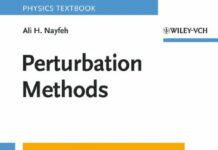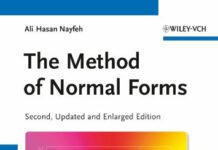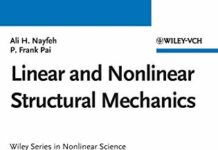
Ebook Info
- Published: 1995
- Number of pages: 704 pages
- Format: PDF
- File Size: 21.69 MB
- Authors: Ali H. Nayfeh
Description
A unified and coherent treatment of analytical, computational and experimental techniques of nonlinear dynamics with numerous illustrative applications. Features a discourse on geometric concepts such as Poincare maps. Discusses chaos, stability and bifurcation analysis for systems of differential and algebraic equations. Includes scores of examples to facilitate understanding.
User’s Reviews
Editorial Reviews: From the Publisher A unified and coherent treatment of analytical, computational and experimental techniques of nonlinear dynamics with numerous illustrative applications. Features a discourse on geometric concepts such as Poincare maps. Discusses chaos, stability and bifurcation analysis for systems of differential and algebraic equations. Includes scores of examples to facilitate understanding. From the Inside Flap Since Poincaré’s early work on the nonlinear dynamics of the n-body problem in celestial mechanics, the twentieth century has seen an explosion of interest in nonlinear systems. Lorenz’s study of a deterministic, third-order system of weather dynamics showed that this system demonstrated a random-like behavior called chaos. Through numerical simulations made possible by modern computers, and through experiments with physical systems, the presence of chaos has been discovered in many dynamical systems. The phenomenon of chaos has, in turn, spurred a great revival of interest in nonlinear dynamics. Applied Nonlinear Dynamics provides a coherent and unified treatment of analytical, computational, and experimental methods and concepts of nonlinear dynamics. Analytical approaches based on perturbation methods and dynamical systems theory are presented and illustrated through applications to a wide range of nonlinear systems. Geometrical concepts, such as Poincaré maps, are also treated at length. A thorough discussion of stability and local and global bifurcation analyses for systems of differential equations and algebraic equations is conducted with the aid of examples and illustrations. Continuation methods for fixed points and periodic solutions and homotopy methods for determining fixed points are detailed. Bifurcations of fixed points, limit cycles, tori, and chaos are discussed. The fascinating phenomenon of chaos is explored, and the many routes to chaos are treated at length. Methods of controlling bifurcations and chaos are described. Numerical methods and tools to characterize motions are examined in detail. Poincaré sections, Fourier spectra, polyspectra, autocorrelation functions, Lyapunov exponents, and dimension calculations are presented as analytical and experimental tools for analyzing the motion of nonlinear systems. This book contains numerous worked-out examples that illustrate the new concepts of nonlinear dynamics. Moreover, it contains many exercises that can be used both to reinforce concepts discussed in the chapters and to assess the progress of students. Students who thoroughly cover this book will be well prepared to make significant contributions in research efforts. Unlike most other texts, which emphasize either classical methods, experiments and physics, geometrical methods, computational methods, or applied mathematics, Applied Nonlinear Dynamics blends these approaches to provide a unified treatment of nonlinear dynamics. Further, it presents mathematical concepts in a manner comprehensible to engineers and applied scientists. The synthesis of analytical, experimental, and numerical methods and the inclusion of many exercises and worked-out examples will make this the textbook of choice for classroom teaching. Moreover, the inclusion of an extensive and up-to-date bibliography will make it an invaluable text for professional reference. From the Back Cover Since Poincaré’s early work on the nonlinear dynamics of the n-body problem in celestial mechanics, the twentieth century has seen an explosion of interest in nonlinear systems. Lorenz’s study of a deterministic, third-order system of weather dynamics showed that this system demonstrated a random-like behavior called chaos. Through numerical simulations made possible by modern computers, and through experiments with physical systems, the presence of chaos has been discovered in many dynamical systems. The phenomenon of chaos has, in turn, spurred a great revival of interest in nonlinear dynamics. Applied Nonlinear Dynamics provides a coherent and unified treatment of analytical, computational, and experimental methods and concepts of nonlinear dynamics. Analytical approaches based on perturbation methods and dynamical systems theory are presented and illustrated through applications to a wide range of nonlinear systems. Geometrical concepts, such as Poincaré maps, are also treated at length. A thorough discussion of stability and local and global bifurcation analyses for systems of differential equations and algebraic equations is conducted with the aid of examples and illustrations. Continuation methods for fixed points and periodic solutions and homotopy methods for determining fixed points are detailed. Bifurcations of fixed points, limit cycles, tori, and chaos are discussed. The fascinating phenomenon of chaos is explored, and the many routes to chaos are treated at length. Methods of controlling bifurcations and chaos are described. Numerical methods and tools to characterize motions are examined in detail. Poincaré sections, Fourier spectra, polyspectra, autocorrelation functions, Lyapunov exponents, and dimension calculations are presented as analytical and experimental tools for analyzing the motion of nonlinear systems. This book contains numerous worked-out examples that illustrate the new concepts of nonlinear dynamics. Moreover, it contains many exercises that can be used both to reinforce concepts discussed in the chapters and to assess the progress of students. Students who thoroughly cover this book will be well prepared to make significant contributions in research efforts. Unlike most other texts, which emphasize either classical methods, experiments and physics, geometrical methods, computational methods, or applied mathematics, Applied Nonlinear Dynamics blends these approaches to provide a unified treatment of nonlinear dynamics. Further, it presents mathematical concepts in a manner comprehensible to engineers and applied scientists. The synthesis of analytical, experimental, and numerical methods and the inclusion of many exercises and worked-out examples will make this the textbook of choice for classroom teaching. Moreover, the inclusion of an extensive and up-to-date bibliography will make it an invaluable text for professional reference. About the Author Ali H. Nayfeh is a University Distinguished Professor of Engineering Science and Mechanics at the Virginia Polytechnic Institute and State University, Blacksburg, Virginia. Professor Nayfeh is the Editor-in-Chief of the journal Nonlinear Dynamics and the Journal of Vibration and Control. He is the author of Perturbation Methods (Wiley, 1973), Nonlinear Oscillations (coauthored with Dean T. Mook; Wiley,1979), Introduction to Perturbation techniques (Wiley, 1981), Problems in Perturbation (Wiley, 1985), and Method of Normal Forms (Wiley, 1993). Professor Nayfeh’s areas of interest include nonlinear vibrations and dynamics, wave propagation, ship and submarine motions, structural dynamics, acoustics, aerodynamic/dynamic/structure/control interactions, flight mechanics, and transition from laminar to turbulent flows. Balakumar Balachandran is Assistant Professor of Mechanical Engineering at the University of Maryland, College Park, Maryland. His areas of interest include vibration and acoustics control, nonlinear dynamics, structural dynamics, and system identification. Read more
Reviews from Amazon users which were colected at the time this book was published on the website:
⭐I found this book very helpfull and easy to understand. It introduces the most recent qualitative tools for analyzing and understanding the dynamics of nonlinear systems with unified coherent approach. Definitions and techniques are provided with examples and graphs. I recommend it for advanced undergradaute and first-year graduate students.
⭐I really recommend to everyone not to read this book.because it’s not well explained and very hard reading.that’s one of the most complicated and ambiguous books that I ever read.it’s not a suitable book for students who want to learn nonlinear dynamics in any level at university.
⭐
⭐
Keywords
Free Download Applied Nonlinear Dynamics: Analytical, Computational, and Experimental Methods 1st Edition in PDF format
Applied Nonlinear Dynamics: Analytical, Computational, and Experimental Methods 1st Edition PDF Free Download
Download Applied Nonlinear Dynamics: Analytical, Computational, and Experimental Methods 1st Edition 1995 PDF Free
Applied Nonlinear Dynamics: Analytical, Computational, and Experimental Methods 1st Edition 1995 PDF Free Download
Download Applied Nonlinear Dynamics: Analytical, Computational, and Experimental Methods 1st Edition PDF
Free Download Ebook Applied Nonlinear Dynamics: Analytical, Computational, and Experimental Methods 1st Edition



